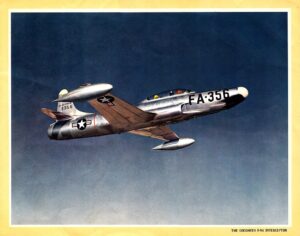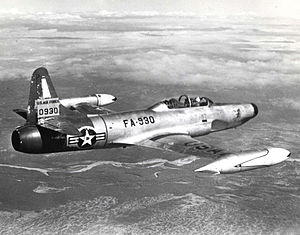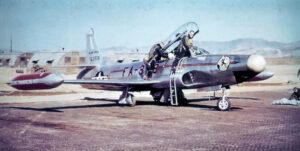16 April 1949 – “The Lockheed F-94 Starfire was a first-generation jet aircraft of the United States Air Force. It was developed from the twin-seat Lockheed T-33 Shooting Star in the late 1940s as an all-weather, day/night interceptor. The aircraft reached operational service in May 1950 with Air Defense Command, replacing the piston-engined North American F-82 Twin Mustang in the all-weather interceptor role.

The F-94 was the first operational USAF fighter equipped with an afterburner and was the first jet-powered all-weather fighter to enter combat during the Korean War in January 1953. It had a relatively brief operational life, being replaced in the mid-1950s by the Northrop F-89 Scorpion and North American F-86D Sabre.
In March 1951, upgraded F-94Bs were received from Lockheed by the 33d Fighter Wing at Otis AFB, Massachusetts, replacing their F-86A Sabres, although the last squadron of the wing didn’t replace its Sabres until May 1952. Three Federalized Air National Guard units, the 121st FIS (DC ANG), 142nd FIS (Maine ANG), and 148th FIS (Pennsylvania ANG), received F-94Bs while they served on active duty during the Korean War call-up to defend the airspace over Washington, D.C. However, these F-94s were retained by the USAF when these ANG squadrons returned to State control in 1952. Also, seven more squadrons received F-94Bs as part of the rollout from Lockheed.

Three additional squadrons (84th, 436th, and 479th FIS) received F-94Bs in 1953, although these were passed down from squadrons receiving F-94Cs. Beginning in the summer of 1951, the F-94Cs began coming off the production line, with six squadrons being equipped by May 1954. Five more squadrons were equipped in FY 54-55 which ended the production run for the interceptor by Lockheed.
Far East Air Force
In the Pacific, Far East Air Force (FEAF) equipped three squadrons with F-94Bs, and Air Defense Command deployed the 319th Fighter-Interceptor Squadron to South Korea to provide a jet air-defense umbrella over the Seoul area.
The first shipment of F-94Bs arrived in Japan in March 1951, being assigned to the 339th Fighter-All Weather Squadron at Johnson Air Base. Also arriving was a mobile training unit from Chanute AFB, Illinois to provide transition training for the F-82G Twin Mustang pilots into the new jet interceptor. In May, F-94Bs began to re-equip the 68th FAWS at Itazuke Air Base, while rotating pilots and radar operators to Suwon Air Base in South Korea where they flew combat missions over North Korea with the F-82Gs as well as air defense alert over Seoul. In July, the 4th FAWS began receiving the F-94As at Naha Air Base, Okinawa. Training for the squadrons proceeded through the summer and in August, the first Fifth Air Force Operational Readiness Test was held by the 339th FAWS with the F-94. Various issues with the aircraft, as well as issues with the Ground Control Interception radar graded the test as “fair”.
In early December 1951, the appearance of Communist MiG-15 jets over Seoul raised alarm bells at FEAF Headquarters. The only interceptors over Seoul were about six F-82Gs along with some Marine Grumman F7F Tigercats. FEAF ordered the 68th to move two F-94Bs to Suwon to supplement the F-82Fs. The Twin Mustangs along with the F7Fs would continue their armed reconnaissance and weather missions against North Korean targets, while the F-94s would fly interception missions over South Korea and the Yellow Sea. Care was taken to not fly the Starfires anywhere that a crash would allow the communists access to the wreck if it were shot down.

In January 1952, ADC was ordered to deploy the 319th Fighter-Interceptor Squadron from the 25th Air Division at Larson AFB, Washington to Japan, and to relieve the 68th FIS at Itazuke. A detachment of the ADC squadron was sent to Misawa AB to fly air defense missions over Northern Honshu and Hokkaido against any intruding Soviet aircraft from Sakhalin Island or the Vladivostok area. At Suwon, the 68th had a total of fifty-eight interceptions during February during nighttime hours. It was in February 1952 that the first F-94 was lost in a night interception while pursuing an unknown aircraft over the Yellow Sea. The cause of the loss was unknown. However, a B-26 pilot observed an explosion in the air between the island of Taeyonp’yong-do and the city of Haeju in North Korea. A search was made for the aircraft and crew, which continued for almost three months. It was finally concluded the aircraft had crashed and broken up over the Yellow Sea, with the wreckage settling in deep water with the classified equipment lost at sea.
In March 1952 the 319th FIS began flying operational missions at Suwon, providing Combat Air Patrols (CAPs) for B-29 Superfortress missions at night. The 68th was relieved and reassigned to Japan, but would remain on one-hour alert for possible combat duty over Korea. In June, the first F-94 contacts against enemy jets were made and the interceptor crews believed at the time that the communists were testing radar-warning equipment. On several occasions just when they were ready to fire on the enemy aircraft, it would start evasive action that indicated the MiGs were equipped with a form of warning radar (as the F-94s were).[5] Other intercepts would take place over North Korea and the F-94 was credited with several air-to-air victories, including the first jet-vs.-jet night victory against a MiG-15. One F-94 was listed as lost due to enemy action, six more to non-enemy causes on combat missions, two were declared as missing on a combat mission and three were lost in accidents.[10] One F-94 was lost when it slowed to 110 miles per hour (180 km/h) during the pursuit of a Po-2 biplane.
After the Armistice in Korea in June 1953, the F-94s continued to fly air defense missions over Japan and South Korea. Beginning in 1954, the F-86D Sabre began replacing it in operational service. By the end of 1954, the Starfires had been returned to the United States for Air National Guard duty. The last aircraft left active-duty service in 1958 and Air National Guard service in 1959.”
Source: Wikipedia
